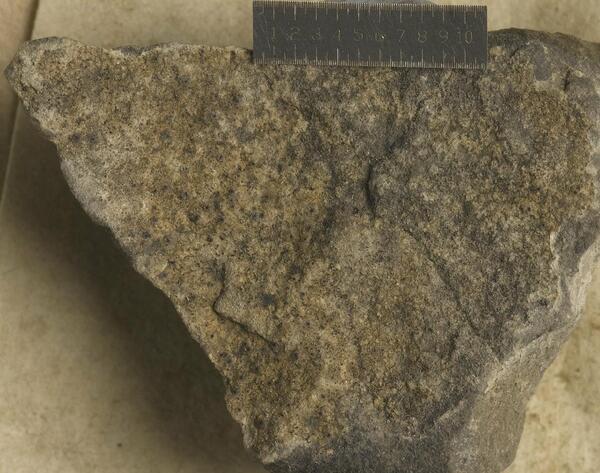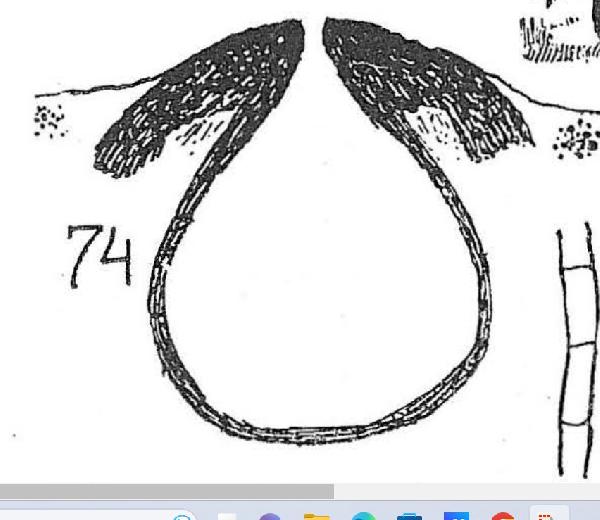Verrucaria tabacina (A. Massal.) Trevis.
Consp. Verruc.: 8, 1860. Basionym: Lithocia tabacina A. Massal. - Symmicta Lich.: 90, 1855.
Synonyms:
Distribution: N - Ven (Lazzarin 2000b). S - Camp (Aprile & al. 2003), Cal (Puntillo 1996).
Description: Thallus crustose, thinly episubstratic, pale brown to reddish brown, finely and irregularly rimose-areolate, without a clear prothallus, the sterile areoles up to 0.4 mm wide, the fertile ones to 1 mm wide, uneven, with sharply angular margins. Cortex 20-40 μm thick; algal layer up to 80 μm thick. Perithecia sparse, basally immersed in the rock, the upper parts immersed into c. 1 mm wide, slightly convex to hemispherical thalline warts, the apical part brownish black, up to 0.3 mm across, with a hardly visible ostiole. Involucrellum limited to the apical part, laterally widely diverging from exciple, clearly wider than exciple, up to 0.6 mm across; exciple pear-shaped, up to 0.4 mm across, the wall dark brown, 10-15 μm thick; hamathecium of c. 30 μm long periphyses and periphysoids, interascal filaments absent; hymenial gel hemiamyloid, I+ red (I+ blue at very low concentrations of I), K/I+ blue. Asci 8-spored, clavate, I-, fissitunicate, the wall thickened above, with an ocular chamber, dehiscent by extrusion of an endotunica to form a delicate rostrum, Verrucaria-type. Ascospores 1-celled, hyaline, ellipsoid, 25-32 x 13-16 μm. Photobiont chlorococcoid. Spot tests: K-, C-, KC-, P-, UV-. Chemistry: without lichen substances.Note: a poorly known species of calcareous rocks reported from several localities in Central Europe (see Breuss 2006); it has been frequently considered as a synonym of V. nigrescens.
Growth form: Crustose
Substrata: rocks
Photobiont: green algae other than Trentepohlia
Reproductive strategy: mainly sexual
Pioneer species
Poorly known taxon in need of further study
Commonnes-rarity: (info)
Alpine belt: absent
Subalpine belt: absent
Oromediterranean belt: absent
Montane belt: rare
Submediterranean belt: rare
Padanian area: rare
Humid submediterranean belt: rare
Humid mediterranean belt: rare
Dry mediterranean belt: absent

Predictive model
Herbarium samples

Natural History Museum (2014). Dataset: Collection specimens. Resource: Specimens. Natural History Museum Data Portal (data.nhm.ac.uk). https://doi.org/10.5519/0002965 Retrieved: 14:36 19 Dec 2021 (GMT)
Growth form: Crustose
Substrata: rocks
Photobiont: green algae other than Trentepohlia
Reproductive strategy: mainly sexual
Pioneer species
Poorly known taxon in need of further study
Commonnes-rarity: (info)
Alpine belt: absent
Subalpine belt: absent
Oromediterranean belt: absent
Montane belt: rare
Submediterranean belt: rare
Padanian area: rare
Humid submediterranean belt: rare
Humid mediterranean belt: rare
Dry mediterranean belt: absent

Predictive model
| Herbarium samples |

 INDEX FUNGORUM
INDEX FUNGORUM
 GBIF
GBIF
 DOLICHENS
DOLICHENS



